By Adrienne Meyer and Stephen Van Dyk
Among the more than half a million pieces of trade literature held at Smithsonian Libraries, the Cooper Hewitt Museum Library’s Geo. F. Sargent’s illustrated catalogue and price list for 1886 is an early rare nineteenth century catalog that focuses on the manufacture and sale of furniture and medical apparatuses geared to meet the needs of the disabled. It features then state of the art wheelchairs that employed modern mechanisms and lightweight frames, furnished with lush contemporary ornamentation and velour or leather upholstery appropriate for any Victorian parlor. The catalog chronicles the growth and marketing of mass-produced patent furniture, the promotion of products that thoughtfully address comfort and mobility, capitalization on an under-served niche market, and the emerging age of American innovation and invention.
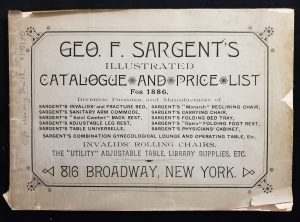
A small sixty-four page paperback, Sargent’s illustrated catalogue, reads as a personal narrative of the firm’s owner and chief inventor, George F. Sargent. Beginning in New York City in the 1870s, the Sargent firm operated as a furniture manufacturer at various locations. By the 1890s, the company was known for “Invalid Goods, hospital supplies, library and furniture specialties”. In this 1886 catalog, Sargent describes his Monarch Reclining Chair as a result of experiments, where one can adjust the back, seat and foot rest up to 384 positions, designed to elegantly fit into any contemporary interior, and geared to those suffering from ailments i.e. asthma, heart trouble, hip and spinal troubles, bone fractures. Also featured are a carrying chair, “rolling invalid” wheelchairs, a spring action exercise chair called “the Health Jolting Chair”, “sanitary” commodes, commode chairs and rubber goods, leg rests, folding back rests, bed trays, bookcases reading & music stands , and adjustable beds and tables.
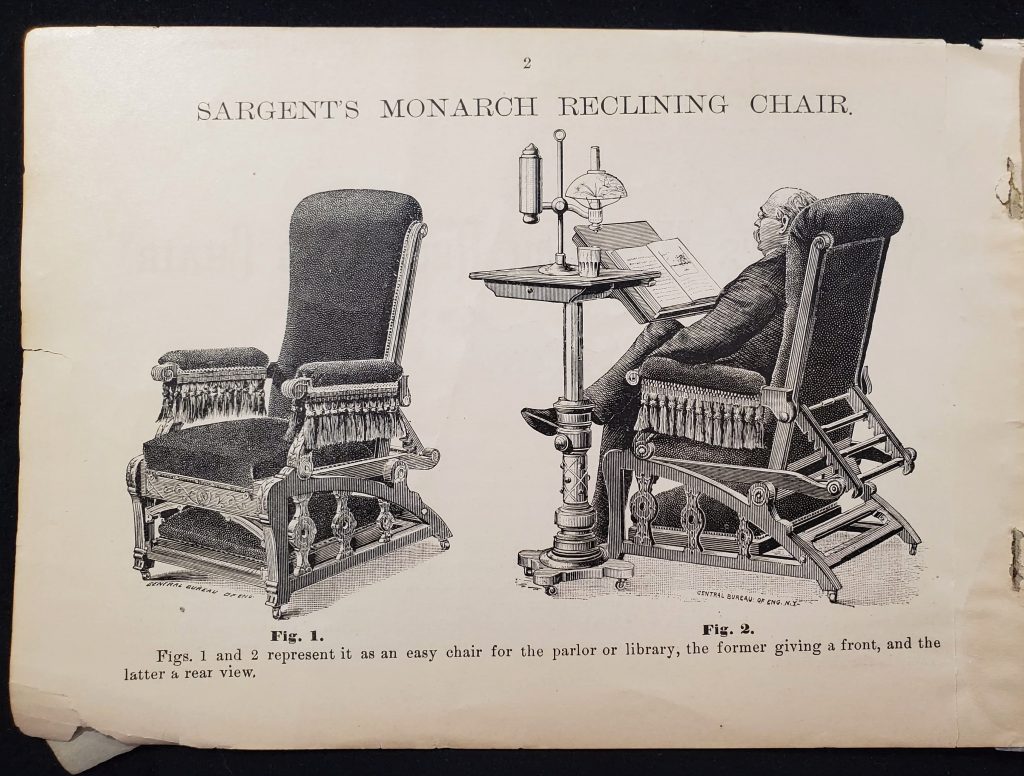
There were many landmark inventions that addressed the need to transport the disabled. The National Museum of Civil War Medicine’s online exhibition “Wheelchairs through the ages” provides a concise history of wheelchairs. No doubt, Sargent was familiar with earlier wheelchair innovations patented by colleagues working in America. Notable examples include Thomas Minnis’ “locomotive chair” of 1853, A. Blunt and Jacob Smith’s spring reclining chair of 1865, George Wilson’s “iron chair”, and Isaac Daan and Dan Kelsey’s folding light-weight chair manufactured by the New Haven Chair Co. in 1878.

Like his contemporaries, Sargent developed patents to improve the flexibility, comfort, and mobility of the wheelchair, exploring lightweight and new materials, employing existing or creating mass-produced components, and incorporating the latest technologies on spring pivoting seats, braking mechanisms, and rubber cushioned wheels. For example, the tension wire spoke wheel and the pneumatic tire, developed by bicycle manufacturers in the 1860s -1870s, can be found on Sargent’s Invalids’ Reclining Rolling Chair. No. 42. He writes “Since the introduction of the Reclining Rolling Chair in 1865, many important improvements in its construction have been made, and it is now one of the best for those unable to walk. By its use the invalid is enabled to assume any position, and propel himself from place to place with pleasure”. He notes the lighter weight and flexibility of the cane back, seat and leg rests, an outside wheel rim “to save the hands from contact with dirt”, and tires that promote comfort and prevent noise. A key goal for Sargent was to devise a chair that could be self-propelled, usable outside as well as inside –both expanding the mobility and independence of the user.
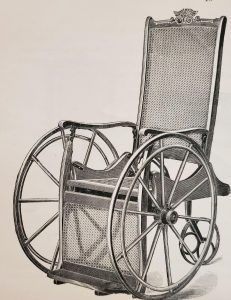
Inventing, manufacturing, and marketing of items for the disabled grew significantly to meet the needs of an estimated 80,000 wounded and disabled Civil War veterans returning to peacetime America after 1865. Additionally, new “special needs” products were created to support advancements and improvements in hospitals, medicine, hygiene, and patient care. As scholars today research the evolution of design for the disabled, trade catalogs like Geo. F. Sargent’s illustrated catalogue and price list for 1886 offer an important insight to merchandise available for the disabled in Victorian America. It demonstrates how innovative entrepreneurs incorporated the latest technologies and materials in their products, and, at that time, how inventors like Sargent created objects that were comfortable and promoted mobility.
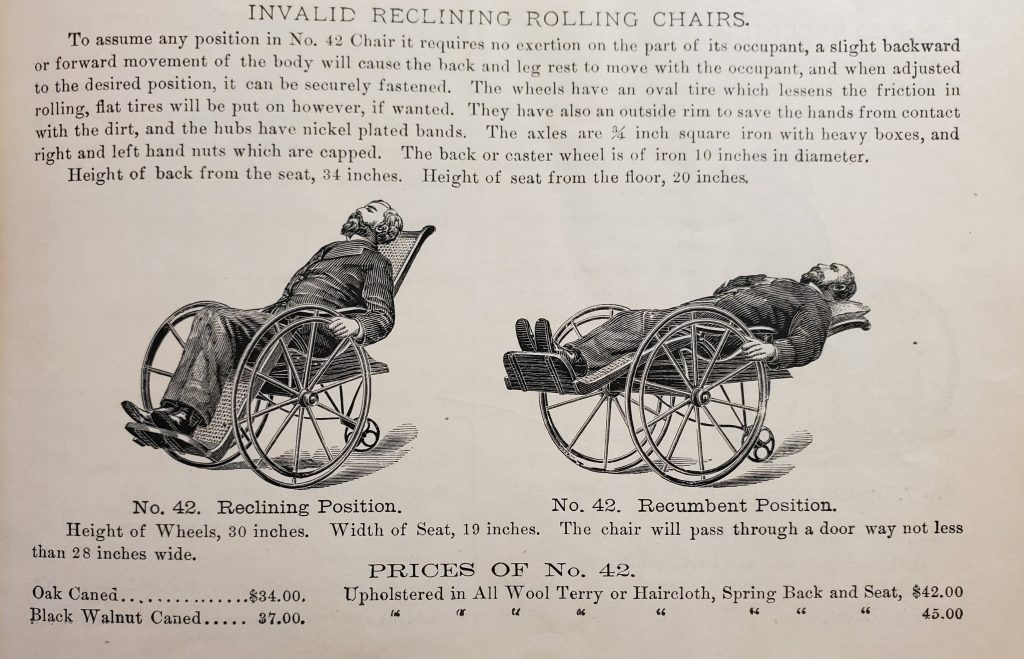

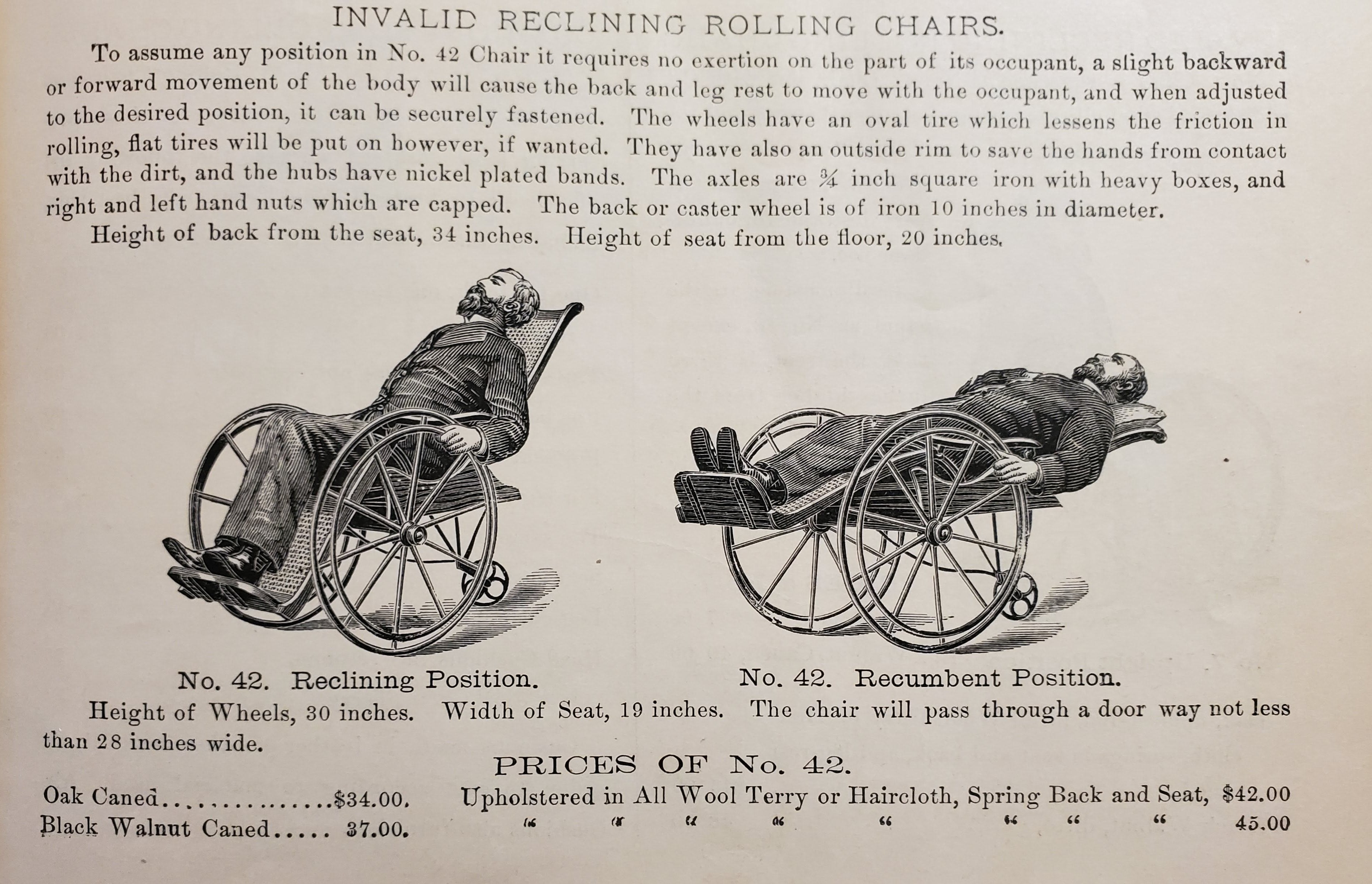
4 Comments
It’s interesting to see that the illustrations seem to be taken from the 1879 New Haven Folding Chair catalog–I wonder if this means Sargent Mfg. Co. acquired New Haven Folding Chair in the 1880s. Thanks for the article!
Your information was much appreciated. I have “The “PERFECTION” Adjustable Table and Reading Stand and was wondering what the value might be. I am older and must arrange to deal with ‘my thing’ before going to a senior housing facility.
Any information you can provide on the piece will be appreciated.
I have a Geo. Sargent Chair in Original Beautiful Condition from The Lane Estate-Dodge Estate in MI. I am ready to part with it but I hate the thought of selling it in a garage sale after all these years my Mom treasured it. I never found another one like it, only ads. Would you be interested in it? I would love to donate it if you could display it?
Hi Nancyjo, thank you for comment. The Smithsonian Libraries and Archives doesn’t collect furniture, but you may want to reach out to our colleagues at the Cooper-Hewitt, Smithsonian Design Museum: https://www.cooperhewitt.org/
Best,
Erin Rushing
Outreach Librarian